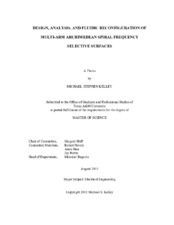| dc.contributor.advisor | Huff, Gregory | |
| dc.creator | Kelley, Michael | |
| dc.date.accessioned | 2015-10-29T19:41:17Z | |
| dc.date.available | 2015-10-29T19:41:17Z | |
| dc.date.created | 2015-08 | |
| dc.date.issued | 2015-06-17 | |
| dc.date.submitted | August 2015 | |
| dc.identifier.uri | https://hdl.handle.net/1969.1/155486 | |
| dc.description.abstract | Frequency selective surfaces are periodic structures that exhibit a frequency dependent response when interacting with electromagnetic radiation. Several applications include radome design, radar cross section reduction, antenna subreflector design, and minimization of electromagnetic interference. Typical designs have unit cells on the order of half of a wavelength. This size requires practical surfaces to be electrically large, and the unit cell spacing excites unwanted grating lobes. Various reconfiguration mechanisms have been studied in order to increase the dynamic frequency range of the surface. Some common tuning mechanisms include varactors, RF MEMS, and ferrite materials, which are all active designs. Active frequency selective surfaces require additional design considerations for the inclusion of a biasing network and isolation between the DC and RF signals. In some applications spaces, such as electronic warfare and space exploration, active frequency selective surfaces are vulnerable to high energy phenomenon. This work studies various Archimedean spiral frequency selective surface designs, and uses dielectrically tunable fluids as the reconfiguration mechanism.
The unit cell topology of this work is that of a multi-arm Archimedean spiral whose electrical size of the unit cell is smaller than half of a wavelength. Electric field plots of the spiral indicate that the arms of the spiral behave like quarter wave transmission line resonators. Further investigations include dual-band operation, an equivalent circuit model, lattice structure effects, and circular polarization transparency. These results help to further the understanding of how this class of frequency selective surface operates.
Fluidic reconfiguration offers an alternative tuning mechanism to traditional active designs. Fluidic systems do not require biasing or isolation circuits. The fluidic network in this work consists of a superstrate, comprised of fluidic reservoirs, attached to the copper layer of the dielectrically backed spiral surface. When filled with a dielectric fluid, the surface’s effective dielectric constant increases, which decreases the resonant frequency. Doping the fluid with the high dielectric barium-strontium-titanateoxide particles further increases the effective dielectric constant, and enables tunability using the particle’s volume fraction as the independent variable. Simulated and experimental results of various band-stop and band-pass designs are presented and discussed. | en |
| dc.format.mimetype | application/pdf | |
| dc.language.iso | en | |
| dc.subject | Archimedean spiral | en |
| dc.subject | frequency selective surface | en |
| dc.subject | fluidic reconfiguration | en |
| dc.subject | periodic coplanar transmission lines | en |
| dc.subject | dual-band | en |
| dc.subject | self-resonant | en |
| dc.subject | circular polarization transparency | en |
| dc.subject | quarter wave resonator | en |
| dc.title | Design, Analysis, and Fluidic Reconfiguration of Multi-arm Archimedean Spiral Frequency Selective Surfaces | en |
| dc.type | Thesis | en |
| thesis.degree.department | Electrical and Computer Engineering | en |
| thesis.degree.discipline | Electrical Engineering | en |
| thesis.degree.grantor | Texas A & M University | en |
| thesis.degree.name | Master of Science | en |
| thesis.degree.level | Masters | en |
| dc.contributor.committeeMember | Nevels, Robert | |
| dc.contributor.committeeMember | Han, Arum | |
| dc.contributor.committeeMember | Porter, Jay | |
| dc.type.material | text | en |
| dc.date.updated | 2015-10-29T19:41:17Z | |
| local.etdauthor.orcid | 0000-0002-6185-4937 | |


